story by Michelle Sutton; photos courtesy Ellen Krzemien unless noted

For weeks after my interview with Ellen Krzemien (pronounced CRAZE-men), the beautiful produce I bought from her and her husband Jon stayed crisp in my fridge. Growing vegetables with her father’s expert guidance, The Krzemiens are helping to preserve their century-old family farm in the village of Springville, southeast of Buffalo. In recent years, Krzemien’s flowers and her already-iconic Flower Stand have emerged as a key resource for the farm as well.
In 2007, Krzemien moved back to the family farm to help her parents. Always interested in home décor, she formed the Home Staging Source, one of the few companies of its kind in western New York. She prepared occupied homes for sale by working with the homeowners on simplifying and beautifying their décor so that potential homebuyers could better see possibilities for themselves. In the early years of the business, she would also pull from her own warehouse of furniture, accents, and art to stage vacant homes on the market. In the off-season, she still does occupied home staging, but she let go of the vacant home staging, which proved too labor-intensive to be profitable.
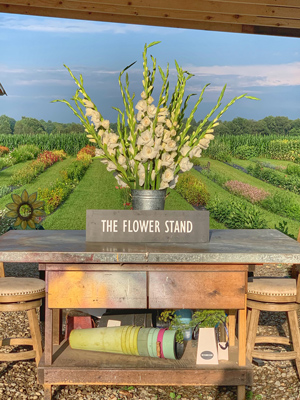
An avid gardener since childhood, Krzemien began growing flowers on the family farm to supply her home staging business. “Eventually I started putting bouquets out on the veggie stand and found they sold out quickly,” she says. “Then I was asked to provide flowers for weddings and other events; that evolved into having a U-Pick, which we keep expanding, and beginning in 2017, we started offering CSA flower subscriptions.” A blog post about the Flower Stand appeared on stepoutbuffalo.com in 2018 and went viral, reaching more than 10,000 readers. “Things really blew up after that,” she says.
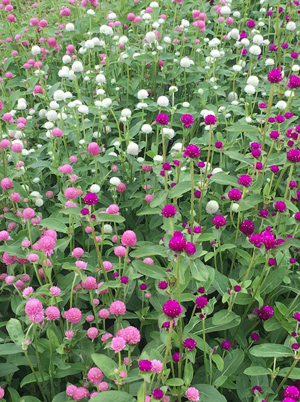
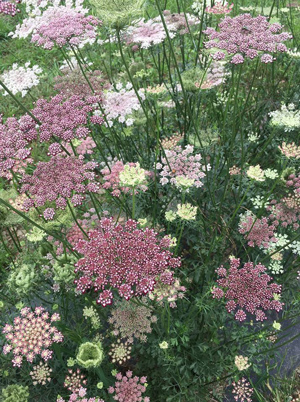
So successful has Krzemien’s enterprise been that last fall she was awarded a $25K Ignite Buffalo grant, part of a regional million-dollar Facebook Community Boost grant. As part of the competition, Krzemien presented her business plan (and showed off jugs of her flowers) to the grants panel and community members. She’s using the majority of the money to purchase a flower truck so that she can sell flowers at WNY markets, festivals, and other events and to make deliveries to CSA members and other customers.
Running a CSA serves a practical purpose for every type of grower: subscriptions are purchased in the winter months, funding the acquisition of seeds and supplies at the time they are needed. “It also helps greatly with planning and infrastructure to know in advance how much income you’ll have coming in,” says Krzemien, a Master Gardener with the Erie County Cornell Cooperative Extension.
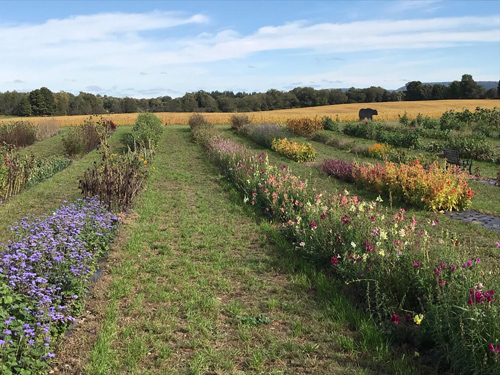
Krzemien says she enjoys the CSA and U-Pick sides of the business equally. The CSA is time-consuming in summer and fall in terms of making deliveries, while the U-Pick is labor intensive in the spring. “The U-Pick is up to one-and-a-half acres of flowers and every seedling is planted by hand, so that’s all we do for the month of May and well into June,” she says. “We do staggered plantings every three weeks of things like sunflowers, zinnias, and snapdragons. We also have two rows of perennials (including ornamental grasses), a few shrubs (mostly butterfly bushes), and one whole row of tuberous plants like dahlias that have to be dug up in the fall. The latest addition is 350 perennial lavender plants that will be ready for U-Pick in 2020.”
Krzemien chooses to plow up the U-Pick field (minus the shrubs and perennials) entirely each spring, creating rows anew and reseeding grass in the aisles. “We like to have wide pathways so that the rows can be accessed by tractors for watering, wagons, strollers, and wheelchairs,” she says. “It’s important to me that this be a place families can come, take pictures, and have a relaxing time.” To that end, Krzemien has a free “Little Library” outpost, where grandparents can select a book to read to kids while their parents are cutting flowers.
Krzemien is herself a grandmother to her daughter Jessica’s kids, Milana (5) and Luis (Tre) (3), who live nearby. Her daughter Jordan lives in Italy with her new husband. “In early June we went to Italy for their wedding,” Krzemien says. “For obvious reasons, Jordan assured me she would not pick a date in July or August,” she says, smiling.
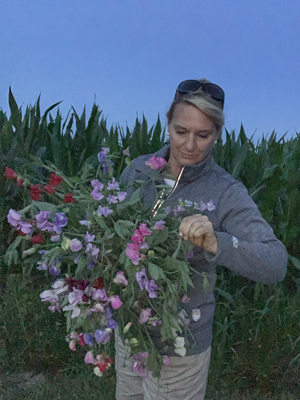
When poring through seed catalogs in January and February and ordering seeds, Krzemien tries to ensure a selection of annuals that, along with her perennials, will give her flowers from Mother’s Day all the way to Thanksgiving. Penstemon, red hot poker, peonies, delphinium, and yarrow shine in June for early season bouquets, while gomphrena, snapdragons, and rudbeckia are fall stars. “Little bluestem, if picked before seeds dry out and start dropping, is nice as a filler for a fall bouquet,” she says.
In picking which selections to grow, she looks for good stem length (like tall zinnias instead of compact ones) and finds good options—except for mums. “I do wish I could find a mum that has a decent stem length, but I haven’t had luck with that,” she says. “Also, I make sure to trial things on a limited basis to be sure that their stems grow as described. Sometimes our microclimate doesn’t suit a plant that would grow in a nearby microclimate, or our soil isn’t just right.”
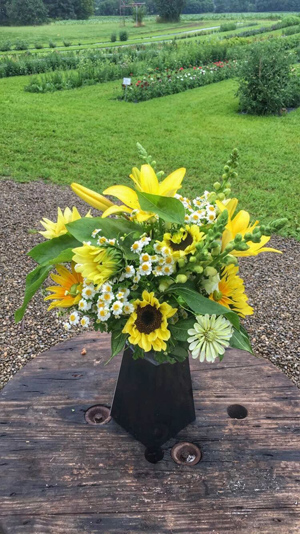
Weather in greater Buffalo can indeed be a challenge, and Krzemien is subject to the weather-related stress of any farmer. Her biggest challenge, however, is deer damage. “One year they ate the whole 200-foot row of sunflowers,” she says. “It was distressing not so much because of the cost of the seed, but because of the lost growing time.” Repellents tend to be too smelly for a U-Pick setting, and she hasn’t found the perfect fencing solution. “If I use a tall fence, it would absolutely detract from the charm and beauty people come here for—they take pictures of the gardens with the rolling land behind them,” she says.
Krzemien is proud to be part of the resurgence of locally grown flowers. “I embrace the principles of the Slow Flower movement,” she says. The customers do, too. “They like coming here as a family and knowing they are supporting a local farmer. They understand that buying local flowers is helping Western NY agriculture as a whole. Plus, most people find that fresh local cut flowers are superior in terms of beauty and longevity.”
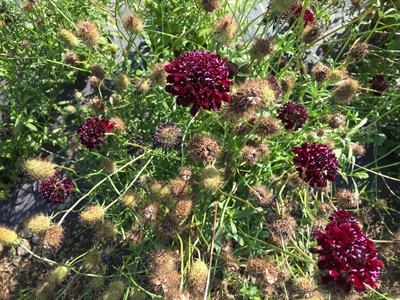
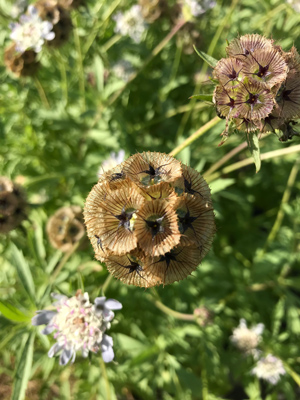
Having done her own experiments with flower preservation, Krzemien is a bleach fan. “I know that might make some florists cringe, but of all the industry and home methods, I’ve found that the vase with a couple of drops of bleach has the longest-lasting, healthiest flowers.” (She recommends that folks recut the stems and change the water every third day at least.)
Currently, Krzemien’s excited about the ornamental qualities of Nigella seed pods (“I have local florists come pick from me”); Daucus carota ‘Dara’ (produces white, burgundy, and pink Queen Anne’s lace flowers); lavender; geum; and Calla lily foliage. She grows all her own seedlings except the notoriously fussy Lisianthus, which she buys in plugs. If you visit The Flower Stand this fall or next season, you can talk flowers with her yourself.
More info:
theflowerstand716.com
instagram.com/theflowerstand716
facebook.com/theflowerstand716
A Few of Krzemien’s Tips on Staging Your Home for Sale:
Landscape and Flowers
– You need to be able to see all or most the house. If you have overgrown trees and shrubs, they have to be tamed. Take down trees and shrubs that are blocking the windows or big ball shrubs that are no longer pleasing to the eye.
– When using fresh flowers inside the home, stick with whites, browns, and greens—they tend to mesh best with peoples’ belongings and with wood and fabric. White flowers are best to prevent clashing with the surroundings. If you choose a yellow daffodil or something colorful, stick it with lots of earthy green foliage and/or brown grasses or seedpods.
– For outside curb appeal, whether you do a container planting depends on the house. If you have a big porch, you might want two pots flanking the entry. However, there’s a hierarchy of needs that comes first before containers: are the outdoor lights clean? Is the flag tattered? Is the doormat new and porch swept? Address these first, and then see if containers will enhance the entrance or not.
Michelle Sutton is a horticulturist, writer, and editor.
Views: 0




